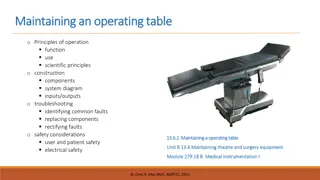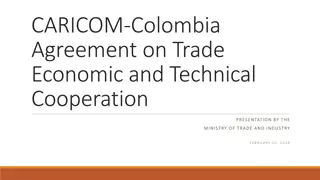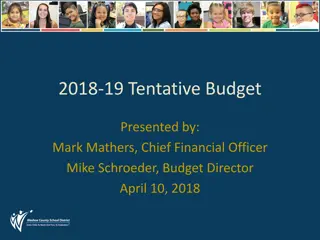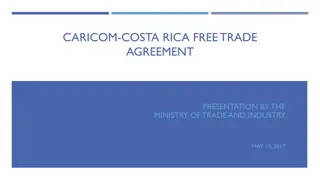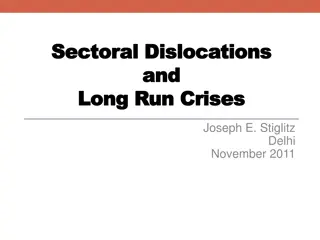Tentative Agreement for Sectoral Table Discussions
This agreement outlines various aspects related to training, knowledge transfer, HR development plans, and diversion strategies. It includes provisions for budget allocations, skills development, dispute resolution mechanisms, and more. The content reflects a comprehensive approach to addressing key issues within the organization.
Download Presentation

Please find below an Image/Link to download the presentation.
The content on the website is provided AS IS for your information and personal use only. It may not be sold, licensed, or shared on other websites without obtaining consent from the author.If you encounter any issues during the download, it is possible that the publisher has removed the file from their server.
You are allowed to download the files provided on this website for personal or commercial use, subject to the condition that they are used lawfully. All files are the property of their respective owners.
The content on the website is provided AS IS for your information and personal use only. It may not be sold, licensed, or shared on other websites without obtaining consent from the author.
E N D
Presentation Transcript
Tentative agreement Sectoral table General assemblies January and February 2024 1
Content of the tentative agreement Content of the tentative agreement Training and knowledge transfer Diversion Self-scheduling Work-time arrangements Displacement Overtime Premiums Seniority Independent labour Regional measures Definition of service National inter-round working committees Other measures specific to personnel classes 2
HR development plan and knowledge transfer 1. Increase the human resources development budget for Class 3 personnel 2. New annual training and coaching budget for employees with less than 2 years of practice (classes 1, 2 and 4) 3
HR development plan and knowledge transfer Increased training and skills development budget for Class 3 personnel The human resources development budget provided for in paragraph 13.01 of the Class 3 collective agreement for office personnel and administrative technicians and professionals will be 0.55% of payroll 4
HR development plan and knowledge transfer New annual training and coaching budget for employees with less than 2 years of practice Annual local budget for the duration of the collective agreement dedicated to training and coaching for employees with less than 2 years of experience in their job who are assigned to the rehabilitation, care and supervision of users: 0.19%* for Class 1 0.10%* for Class 2 0.19%* for Class 4 If the entire amount stipulated is not spent by the employer in the course of a given year, the remaining balance is added to the amount earmarked for such activities in the following year. The parties must agree in local arrangements on how this budget is to be used. * Percentage of the payroll of personnel in this class who are assigned to the rehabilitation, care or supervision of users. 5
Diversion 1. Introduction of mediation / arbitration 2. Letter of agreement on the diversion of labour relations away from the courts 3. Letter of agreement on the health and social services system's new HR information system 4. Information provided to unions 5. Expansion of list of grievances handled through preparatory conferences 6. Harmonization of the time limit for filing a psychological harassment complaint with the Act respecting labour standards 7. National working committee on disputes and grievances related to the health crisis 6
Diversion Introduction of mediation / arbitration in article 11 of the collective agreement The process is voluntary List of mediators / arbitrators or chosen by local parties If mediation / arbitration does not result in an agreement, the parties recognize that the mediator / arbitrator will be validly seized of the grievance(s) and have the authority to rule on the merits Costs shared equally between the parties 7
Diversion Letter of agreement on the diversion of labour relations away from the courts Local working committee The national parties suggest that local parties establish a working committee to undertake an intensive process to settle disputes and grievances arising from the national provisions of the collective agreement and the locally negotiated and agreed stipulations in force prior to (date of coming into force of the new national provisions of the collective agreement). Mediation / arbitration The national parties encourage local parties to use the mediation / arbitration procedure provided for in article 11 of the national provisions of the collective agreement or any other alternative dispute resolution method. 8
Diversion (cont'd) National follow-up The national parties agree to submit the following matters to the permanent national negotiating committee: a. Analyze the effects of the new provisions in the collective agreement concerning diversion b. Agree on indicators c. Make recommendations to the national negotiating parties 9
Diversion Letter of agreement on the health and social services system's new HR information system a) A transitional period has already been provided for the acquisition and implementation of a human resources information system b) During this period, the CPNSSS will keep the FSSS-CSN informed of progress on the acquisition and implementation of the system c) During this period, the national parties recommend that, technology or the information system permitting, institutions where local unions currently have no access to the employer's HR information system facilitate union access to the schedule module at no cost to the Employer, subject to the Employer's obligations under Act to modernize legislative provisions as regards the protection of personal information. 10
Diversion Information provided to unions Amend paragraph 6.07 as follows: 6.07 Once a month, the employer provides the union with two copies of a list of new employees, indicating the following information: hiring date, address, email address when available, job title, service, rate of pay, employee number, social insurance number and status; as well as a list indicating departure dates The list of departures must indicate the service in which the employee worked. Expand the list of grievances handled through a preparatory conference Amend paragraph 11.16 of the national provisions of the collective agreement concerning preparatory conferences to cover all grievances 11
Diversion Harmonization of the time limit for filing a psychological harassment complaint with the Act respecting labour standards Change the 90-day limit in paragraphs 3.09 and 10.01 of the collective agreement to 2 years National working committee on disputes and grievances related to the health crisis Create a joint national working committee on the settlement of disputes and grievances related to the health crisis 12
Self-scheduling Add a Letter of Agreement on self-management of work schedules The purpose of this Letter of Agreement is to encourage employee involvement in drawing up and managing their schedules in order to improve the predictability and stability of their schedules and the continuity of care and services, while improving work-life-study balance. This is a voluntary, flexible and proactive form of shared schedule management based on the participation and empowerment of employees in planning their work schedules. This approach involves measures that allow employees to participate in drawing up and changing their schedules, while taking into account the needs of other team members, of the service and of the units of care. Team composition The process of self-management of work schedules (hereafter "self-scheduling") includes employees holding positions with the same job title. This process also includes employees with the job title who are part of the float team and part-time casual employees when they are assigned to the self-managed service or unit of care for the duration of the schedule period. 13
Self-scheduling Before self-scheduling is introduced for a job title in a service or unit of care, the employer notifies the local union that self-scheduling is being adopted. The local union can ensure that the self-scheduling team voluntarily subscribes to this model. The main steps in self-scheduling include: Identification and communication of guidelines by the manager regarding needs of the activity centre and number of staff required; Establishment of the schedule, including the following steps: Step 1: Indicate preferences for hours associated with each position, leave, addition of availability and non-availability, scheduling of on-call duty times, open shifts, at regular time; Step 2: Add overtime shifts on a voluntary basis; Step 3: Fill remaining needs in accordance with the local provisions of the collective agreement; Posting of schedules according to the terms and conditions set by the team. 14
Self-scheduling In each of the above steps, the manager and the team balance the work schedule based on the guidelines and identified needs. Notwithstanding the foregoing, if this process does not work out, the self-scheduling team can return to a model whereby preferences are indicated in accordance with the local provisions of the collective agreement until the next scheduling period. The self-scheduling team and the manager must ensure that employees who arrive mid-schedule are added to the schedule. 15
Self-scheduling A self-scheduling team can determine the following, among other things: Method of decision-making Scheduling period (minimum 4 weeks to maximum 26 weeks) Time frames and terms for planning, establishment and modification of schedules Procedure for adding assignments Method of granting overtime on a voluntary basis Terms for arranging work hours or the regular work week Communication tools to be used to facilitate self-scheduling The terms and conditions determined by the self-scheduling team are recorded in writing. They must be submitted to the manager and the local union. Any terms and conditions not covered by an agreement are governed by the local provisions of the collective agreement. 16
Self-scheduling Self-scheduling employees can voluntarily arrange their own work schedule, including the following options: Choose to have a regular work day of more than 8 hours Choose a schedule that does not have the minimum 16-hour interval between 2 shifts during a shift change Exchange shifts within the current schedule Work more than one weekend out of two Choose another arrangement of hours or regular work week Work more than 5 consecutive days 17
Self-scheduling Notwithstanding the voluntary nature of self-scheduling, this model cannot result in a change in the constituent elements of the position for a member of the self-scheduling team or reduce the number of hours for that position. Given the voluntary nature of the self-scheduling model, the team can terminate the process after confirming that it no longer subscribes to this management model. When a position is posted, the local parties agree to indicate that the position is currently in a service or unit of care that is using the self-scheduling model. 18
Self-scheduling The labour relations committee is mandated to implement this Letter of Agreement and to monitor its application. The national parties agree to mandate the permanent national negotiating committee to discuss issues encountered by the parties. 19
Self-scheduling Letter of Agreement on self-scheduling to recognize work attendance Employees in the 4 personnel classes working in self-scheduling services and job titles that provide 24/7 service Lump-sum payment of up to $300 per month The employee receives a lump sum of $100 when they work the equivalent of a full-time schedule in an initial 2-week period The employee receives a lump sum of $200 when they work the equivalent of a full-time schedule in a second consecutive 2-week period At the end of the period of 4 consecutive weeks, an employee who maintains the conditions of eligibility may again receive the above-mentioned lump sums, in the same sequence The lump-sum payment is prorated to regular hours worked during the reference period This measure will expire on March 30, 2028 20
Work-time arrangements 1. 4-day schedule (Appendix P) 2. Atypical schedules (Appendix Y) 3. 9/14 evening schedule for Class 1 (Letter of Agreement #35) 4. Day, evening, night and shift rotation schedule (Letter of Agreement #36) 5. New work-time arrangements for self-scheduling teams 6. Addition of a new weekend schedule with an increased premium 7. An added mandate for the Labour Relations Committee 21
Work-time arrangements 4-day schedule (Appendix P) Allow voluntary access to the arrangement after agreement between an employee and the employer Delete the reference to field of implementation Indicate that when it is not possible to grant a 4-day schedule to all employees who desire it, the employer will take seniority into account 22
Work-time arrangements Atypical schedules (Appendix Y) Allow voluntary access to the arrangement after agreement between an employee and the employer Stipulate that such an agreement must be for a minimum of one year and is renewable Provide that the employer or the employee may terminate the arrangement with 60 days notice; however, the employer and the employee may terminate the arrangement at any time by mutual agreement Allow shifts of up to 16 hours; however, the employer must inform the union of any agreement that provides for a shift of more than 12 hours Indicate that when it is not possible to grant this arrangement to all employees who desire it, the employer will take seniority into account 23
Work-time arrangements Day, evening, night and shift rotation schedule (Letter of Agreement #36) Allow voluntary access to the arrangement after agreement between an employee and the employer Indicate that when it is not possible to grant this arrangement to all employees who desire it, the employer will take seniority into account 24
Work-time arrangements 9/14 evening schedule for Class 1 (Letter of Agreement #35) Allow voluntary access to the arrangement after agreement between an employee and the employer Indicate that when it is not possible to grant this arrangement to all employees who desire it, the employer will take seniority into account 25
Work-time arrangements Work-time arrangements for self-scheduling teams in 24/7 services (Class 1) To work the equivalent of a 9/14 evening schedule, it is possible to convert up to 8.5% of the evening premium and use a minimum of 7 statutory holidays The employer automatically allows 25% of employees who hold a full-time position and work the evening shift, for the entire service, to work the equivalent of a 9/14 evening schedule, upon request. This arrangement is granted in exchange for the employee's commitment to work an additional 4 hours on weekends in their activity centre, up to 17 times per year, at the overtime rate. 26
Work-time arrangements (cont'd) To work the equivalent of an 8/14 night schedule, it is possible to convert up to 18% of the night premium, up to 3 sick days, and to use a minimum of 11 statutory holidays The employer automatically allows 25% of employees who hold a full-time position and work the night shift, for the activity centre, to work the equivalent of an 8/14 schedule, upon request. This arrangement is granted in exchange for the employee's commitment to work an additional 4 hours on weekends in their service, up to 10 times per year, at the overtime rate. In all the above cases, if the members of the team are unable to meet needs when the employee with the work-time arrangement has time off, the employer may terminate the arrangement with at least 4 weeks notice to the employee concerned. 27
Work-time arrangements Addition of a new weekend arrangement with an increased premium (classes 1 and 2) The national parties have agreed to add a new appendix to the collective agreement allowing for a weekend work- time arrangement with an increased premium. It is available to Class 1 employees who desire it and Class 2 assistance care job titles working in 24/7 services. When it is not possible to grant this arrangement to all employees who desire it, the institution will take seniority into account. This new condensed weekend work-time arrangement consists of five 12-hour shifts per 14-day period, all on the weekend, with rotating shifts. Employees who choose this schedule receive a premium of 16% of salary for working weekends, in addition to the premiums currently provided for in the collective agreements. Conversion of part of the inconvenience premiums and the additional premium is possible, in addition to using 10 days of split annual leave, 12 statutory holidays and 3 sick days for personal reasons, to enable the employee to have full-time status. 28
Work-time arrangements An added mandate for the Labour Relations Committee This Committee is mandated to monitor the implementation and application of the work-time arrangements. 29
Displacement Voluntary displacements A new article in the collective agreement provides for lump sum payments to employees who volunteer for an intra- or inter-institutional displacement. Voluntary temporary displacements of employees away from their home base are subject to the local and national provisions of the collective agreement of the employee's home institution. Employees thus continue to receive all of their applicable working conditions and remuneration. Employees affected by such displacements may not receive more than one lump sum payment provided for in this article per day. Lump sum payments provided for in this article are not contributory amounts and are not eligible for pension plan purposes. 30
Displacement Intra-institutional displacement Employees who agree to a temporary displacement to one of the employer's institutions located 20 to 100 kilometres from their home base are entitled to a lump sum payment of $50 per day, on top of the moving allowances provided for in the collective agreement. If the institution is not accessible by vehicle, the lump sum payment in the above paragraph applies even if it is located less than 20 kilometres away. If the facility is located 100 kilometres or more from the home base, the lump sum payment provided for in the above paragraphs is increased to $100. 31
Displacement Inter-institutional displacement Employees who agree to a temporary displacement to a facility of another institution less than 100 kilometres from their home base are entitled to a lump sum payment of $50 per day, on top of the moving allowances provided for in the collective agreement. If the facility is located 100 kilometres or more from the home base, the lump sum payment provided for in the above paragraphs is increased to $100. 32
Overtime 1. Rate for full overtime shifts worked on weekends increased to double time 2. Conversion of overtime on weekend shifts to paid time off 3. Available full-time employees get priority for voluntary overtime 4. The minimum interval between 2 shifts cannot be an obstacle to work-time arrangements and self- scheduling 33
Overtime Rate for full overtime shifts worked on weekends increased to double time In 24/7 services For full shifts on weekends and after the regular work week For employees in all four personnel classes Must keep to work schedule 7 days before and 7 days after the overtime shift Absences for the following reasons will not be penalized: scheduled annual leave statutory holidays union leave (internal and external) conversion of premiums floating days off parental leave, including pregnancy-related medical appointments scheduled time off under work-time arrangements or special agreements (e.g. 9/10 schedule, 4/32 schedule, etc.) personal leave 34
Overtime Overtime on weekend shifts converted to paid time off After 15 full overtime shifts on weekends paid at double time, the employee may choose, starting with the 16th shift, to be paid at time-and-a-half and bank 0.5 days per shift, up to a maximum of 5 days per year. 35
Overtime Available full-time employees get priority for voluntary overtime Notwithstanding any local provisions to the contrary, if overtime is necessary, the employer must offer it first to available full-time employees and to part-time employees who offer and respect full-time availability, on a rotating basis, so as to distribute overtime equitably among these employees who normally perform the work in the service. Minimum interval between 2 shifts Add the following subparagraph to paragraph 8.09 of the collective agreement: o The minimum interval between 2 shifts cannot be an obstacle to work-time arrangements and self- scheduling. 36
Workplace premiums 1. Critical care premium 2. Specific critical care premium 3. Youth centre premium 4. Premium for serious behavioural disorders 5. Psychiatry premium 6. Premium for Class 3 personnel working in emergency departments 7. Premium for continuous-assistance residences 8. CHSLD premium and lump sum 9. Special conditions for prison settings 10.Premium for sorting soiled linen 11.Updated lists of facilities in appendices A, R and T 37
Critical care premium 2021-2023 collective agreement Tentative agreement 12% premium Level 1 15% Enhanced 14% premium* Level 2 14% * For employees who offer and respect 16/28 availability Level 3 10% Level 1 paid for 70 hrs or more Level 2 paid for 42 hrs to less than 70 hrs Level 3 paid for less than 42 hrs 38
Brachytherapy Specific critical care premium Brachytherapy is added to the list of services covered by the specific critical care premium 39
Specific critical care premium 2021-2023 collective agreement Tentative agreement 6% premium Level 1 10% Enhanced 7% premium* Level 2 7% * For employees who offer and respect 16/28 availability Level 3 6% Level 1 paid for 70 hrs or more Level 2 paid for 42 hrs to less than 70 hrs Level 3 paid for less than 42 hrs 40
Youth Centre premium (including DPJ) 2021-2023 collective agreement Tentative agreement 4% premium for Class 2 personnel assigned to the supervision or rehabilitation of users and for Class 4 personnel Level 1 10% Level 2 7% Level 3 6% Temporary additional 3% premium for Class 4 personnel who work in receiving and processing reports, in intake, evaluation and referral, or in enforcement of measures Permanent measure Level 1 paid for 70 hrs or more Level 2 paid for 42 hrs to less than 70 hrs Level 3 paid for less than 42 hrs 41
Premium for serious behavioural disorders 2021-2023 collective agreement Tentative agreement Lump sum per 500 hours actually worked, varying by job title ($195, $295, $360) + conversion of lump sum into time off for some job titles Level 1 3.5% Level 2 2.25% Level 3 1% Temporary measure Permanent measure Level 1 paid for 70 hrs or more Level 2 paid for 42 hrs to less than 70 hrs Level 3 paid for less than 42 hrs 42
Premium for serious behavioural disorders Example: For a health and social services assistant or a beneficiary attendant working with people with serious behavioural disorders (Class 2) With the current lump sum payment: These employees receive the equivalent of $0.39 per hour (currently fixed over time) With the new permanent premium (based on salary on April 1, 2023 at the single rate in ranking 9): Level 1: $0.95 per hour Level 2: $0.68 per hour Level 3: $0.27 per hour 43
Premium for serious behavioural disorders Example: For an educator working with people with serious behavioural disorders (Class 4) With the current lump sum payment: These employees receive the equivalent of $0.59 per hour (currently fixed over time) With the new permanent premium (based on salary on April 1, 2023 at the last echelon in ranking 16): Level 1: $1.32 per hour Level 2: $0.95 per hour Level 3: $0.37 per hour 44
Premium for serious behavioural disorders Example: For a social worker working with people with serious behavioural disorders (Class 4) With the current lump sum payment: These employees receive the equivalent of $0.72 per hour (currently fixed over time) With the new permanent premium (based on salary on April 1, 2023 at the last echelon in ranking 22): Level 1: $0.78 per hour Level 2: $1.27 per hour Level 3: $0.51 per hour 45
Psychiatry premium 2021-2023 collective agreement Tentative agreement Weekly premium of $21.27 as of April 1, 2022 Level 1 3.5% Level 2 2.25% Level 3 1% Level 1 paid for 70 hrs or more Level 2 paid for 42 hrs to less than 70 hrs Level 3 paid for less than 42 hrs 46
Psychiatry premium Example: For a nurse (based on a 37.5-hour week) (Class 1) With the current fixed premium: These employees receive the equivalent of $0.57 per hour With the new premium (based on salary on April 1, 2023 at the last echelon in ranking 19): Level 1: $1.53 per hour Level 2: $1.10 per hour Level 3: $0.44 per hour 47
Psychiatry premium Example: For a Specialized Pacification and Security Worker (new job title replacing Psychiatric Intervention Officer) (based on a 37.5-hour week) (Class 2) With the current fixed premium: These employees receive the equivalent of $0.57 per hour With the new premium (based on salary on April 1, 2023 at the last echelon in ranking 10): Level 1: $1.01 per hour Level 2: $0.71 per hour Level 3: $0.29 per hour 48
Premium for Class 3 personnel in emergency rooms 2021-2023 collective agreement Tentative agreement $195 lump sum per 400 hours actually worked Level 1 2.5% Level 2 1% Level 3 1.5% Definition of levels Level 1 paid for 70 hrs or more Level 2 paid for 42 hrs to less than 70 hrs Level 3 paid for less than 42 hrs 49
Premium for Class 3 personnel in emergency rooms Example: For an Administrative Officer, Class 3 (based on a 35-hour week) With the current lump sum payment: These employees receive the equivalent of $0.49 per hour (currently fixed over time). With the new premium (based on salary on April 1, 2023 at the last echelon in ranking 7): Level 1: $0.64 per hour Level 2: $0.26 per hour Level 3: $0.13 per hour 50







